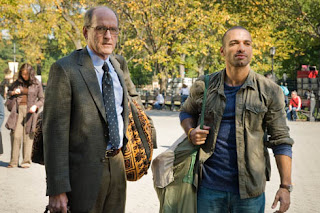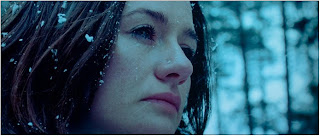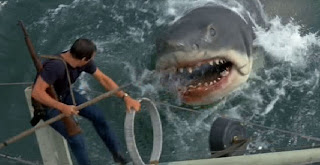미드포인트
How Adding a Midpoint Can Save Your Movie






http://thestorydepartment.blogspot.com/2007/03/that-mid-point-thing.html
Friday, April 20, 2007
That Mid Point Thing
 Many
unsuccessful movies run out of steam halfway. Even a fair few memorable
pics are weak in the middle, or have a 'soft belly'. The Second Act
seems to be the hardest nut to crack. But why? Perhaps because the
protagonist is chasing the same objective all along? After all we have a
massive chunk of script to fill, about an hour of screentime on
average. One remedy is to chop the movie up in quarters. First and last
act are roughly one quarter each already, so Act Two we just cut in two.
Many
unsuccessful movies run out of steam halfway. Even a fair few memorable
pics are weak in the middle, or have a 'soft belly'. The Second Act
seems to be the hardest nut to crack. But why? Perhaps because the
protagonist is chasing the same objective all along? After all we have a
massive chunk of script to fill, about an hour of screentime on
average. One remedy is to chop the movie up in quarters. First and last
act are roughly one quarter each already, so Act Two we just cut in two.
It's
variously called the mid-act climax, the mid-point, first culmination
or the mid-point reversal. I prefer the latter, although it is not
always a strict 180 degree turn. It doesn't necessarily have to be a
climax either but it must be a 'major turning point'. Things will be
dramatically different from this point onwards.
 Syd Field describes it something like this: "An
important scene in the middle of the script, often a reversal of
fortune or revelation that changes the direction of the story."
Field suggests that driving the story towards the Midpoint keeps the
second act from sagging. For once I find Field more helpful than others.
An executive at the talent agency ICM is trying to get his head around
it:
Syd Field describes it something like this: "An
important scene in the middle of the script, often a reversal of
fortune or revelation that changes the direction of the story."
Field suggests that driving the story towards the Midpoint keeps the
second act from sagging. For once I find Field more helpful than others.
An executive at the talent agency ICM is trying to get his head around
it:
"An event occurs wherein
the character cannot give up his pursuit. It is a “no turning back
point.” The bridge has been burned behind him (figuratively speaking),
and he can only move forward. Often, this is manifested as a TICKING
CLOCK. In classically structure (sic) romantic comedies, this is the
point where the man and woman sleep together." Hmmm... Not sure about that last one.
Personally
I don't like the "point of no return" approach too much, even though
the otherwise very wise Michael Hauge mentions it. It's vague and not
very practical in the writing. Here's my favourite definition, from
Frank Daniel:
"Mid-Point or
First Culmination: a Major Reversal of fortune, making Main Character’s
task even more difficult. Often, give the audience a very clear glimpse
of an answer to the Central Dramatic Question – the hope that Main
Character will actually succeed at resolving his problem – only to see
circumstances turn the story the other way. First Culmination may be a
glimpse at the actual resolution of the picture, or its mirror
opposite."
 THE
UNTOUCHABLES - Not only a well-structured, commercial movie with a top
notch cast; it has a midpoint that ticks all three boxes: After a
shootout on the Canadian border far away from the crime-ridden streets
of Chicago, Elliott Ness and his team find out they can get to Capone
through his accountant. The mid-point sequence happens halfway the movie (ironically, not all midpoints really do), it changes the course of the story (Ness is no longer after Capone but after his accountant) and it takes place in a very different environment/change of scenery from the rest of the movie. And indeed: catching the accountant does get Capone in court.
THE
UNTOUCHABLES - Not only a well-structured, commercial movie with a top
notch cast; it has a midpoint that ticks all three boxes: After a
shootout on the Canadian border far away from the crime-ridden streets
of Chicago, Elliott Ness and his team find out they can get to Capone
through his accountant. The mid-point sequence happens halfway the movie (ironically, not all midpoints really do), it changes the course of the story (Ness is no longer after Capone but after his accountant) and it takes place in a very different environment/change of scenery from the rest of the movie. And indeed: catching the accountant does get Capone in court. JAWS
- It's more than thirty years old and scary as ever, and not because of
its state-of-the-art FX. Look closely and you'll see: that plastic
shark is a big joke! This is one piece of brilliant writing. Police
Chief Brody (Roy Scheider) has been unsuccessful in trying to stop the
shark killings by urging the mayor to close the beaches. The midpoint
reversal forces him to change tactics (different direction): he must go and attack the shark in its own habitat. It brings a fresh turn to the movie with a change of scenery
and the stakes are heightened because we are now fighting the killer on
his own territory. What's more: the protagonist is under greater
jeopardy because he can't swim...
JAWS
- It's more than thirty years old and scary as ever, and not because of
its state-of-the-art FX. Look closely and you'll see: that plastic
shark is a big joke! This is one piece of brilliant writing. Police
Chief Brody (Roy Scheider) has been unsuccessful in trying to stop the
shark killings by urging the mayor to close the beaches. The midpoint
reversal forces him to change tactics (different direction): he must go and attack the shark in its own habitat. It brings a fresh turn to the movie with a change of scenery
and the stakes are heightened because we are now fighting the killer on
his own territory. What's more: the protagonist is under greater
jeopardy because he can't swim... ONE
FLEW OVER THE CUCKOO'S NEST - In his book THE SEQUENCE APPROACH, Paul
Gulino mentions another function of the midpoint: it gives the
protagonist a flavour of the possible outcome of the story (Frank Daniel's "glimpse of an answer to the Central Dramatic Question").
Here, Nicholson's character tastes freedom when he takes the patients
out on a trip. The reality however is that after this point he learns he
may never leave the asylum again. A powerful reversal:
rather than proving he's insane, he now has to try and get out. The
scene/sequence of the mad men's outing is another beautiful example of a
change of scenery. At one stage during the edit, director Milos Forman cut the sequence out. About the result he says: "I cut it down television style, under two hours. And you know what was funny? It felt much longer."
ONE
FLEW OVER THE CUCKOO'S NEST - In his book THE SEQUENCE APPROACH, Paul
Gulino mentions another function of the midpoint: it gives the
protagonist a flavour of the possible outcome of the story (Frank Daniel's "glimpse of an answer to the Central Dramatic Question").
Here, Nicholson's character tastes freedom when he takes the patients
out on a trip. The reality however is that after this point he learns he
may never leave the asylum again. A powerful reversal:
rather than proving he's insane, he now has to try and get out. The
scene/sequence of the mad men's outing is another beautiful example of a
change of scenery. At one stage during the edit, director Milos Forman cut the sequence out. About the result he says: "I cut it down television style, under two hours. And you know what was funny? It felt much longer."I wouldn't necessarily call the following movies class examples but I'll give them any way because their mid-points worked really well for me:
 THE
PARALLAX VIEW - Bang in the middle of this classic conspiracy thriller,
Warren Beatty's character undergoes a five minute brainwashing. The
scene is borderline unbearable and would have probably been cut by
today's studio heads. We undergo the character's psychological torture
first hand while we stare at the seemingly random images, exactly like
the protagonist experiences them. After this, Beatty's character is no
longer the curious outsider vs. the mysterious corporation; he is
fighting the system from within, which will ultimately lead to his
demise.
THE
PARALLAX VIEW - Bang in the middle of this classic conspiracy thriller,
Warren Beatty's character undergoes a five minute brainwashing. The
scene is borderline unbearable and would have probably been cut by
today's studio heads. We undergo the character's psychological torture
first hand while we stare at the seemingly random images, exactly like
the protagonist experiences them. After this, Beatty's character is no
longer the curious outsider vs. the mysterious corporation; he is
fighting the system from within, which will ultimately lead to his
demise. GIU
LA TESTA (A FISTFUL OF DYNAMITE) - Very much like in THE PARALLAX VIEW,
we share the point of view of Rod Steiger's character Juan while he
watches what will cause a major change in his personality and in the
course of the movie. At the very midpoint in the movie Juan witnesses a
lengthy, traumatic shootout with a life-changing effect: from a mindless
and merciless robber dreaming of the ultimate big heist he has now
become a freedom fighter and finally commits to the cause of his
alter-ego Sean (incarnated wonderfully by James Coburn).
GIU
LA TESTA (A FISTFUL OF DYNAMITE) - Very much like in THE PARALLAX VIEW,
we share the point of view of Rod Steiger's character Juan while he
watches what will cause a major change in his personality and in the
course of the movie. At the very midpoint in the movie Juan witnesses a
lengthy, traumatic shootout with a life-changing effect: from a mindless
and merciless robber dreaming of the ultimate big heist he has now
become a freedom fighter and finally commits to the cause of his
alter-ego Sean (incarnated wonderfully by James Coburn). THE
QUEEN - The Queen is stuck in the lonely hills near Balmoral, her Land
Rover having let her down. Without help from anybody she is out of her
comfort zone when she notices the dear her grandsons have been stalking,
upon her own advice and encouragement. A moment of realisation (with a
lot of symbolism) leads to the decision to chase the dear away in an
attempt to save its life from the hunters. The parallel with Princess
Diana's end becomes even more apparent when it turns out the deer was
shot by a group of hunters after a chase on a neighbouring land
(France?). The Queen has witnessed something that has changed her view
and we see it externalised in her lukewarm response to the Queen
Mother's statements about the British people in a following scene.
THE
QUEEN - The Queen is stuck in the lonely hills near Balmoral, her Land
Rover having let her down. Without help from anybody she is out of her
comfort zone when she notices the dear her grandsons have been stalking,
upon her own advice and encouragement. A moment of realisation (with a
lot of symbolism) leads to the decision to chase the dear away in an
attempt to save its life from the hunters. The parallel with Princess
Diana's end becomes even more apparent when it turns out the deer was
shot by a group of hunters after a chase on a neighbouring land
(France?). The Queen has witnessed something that has changed her view
and we see it externalised in her lukewarm response to the Queen
Mother's statements about the British people in a following scene. NORTH
BY NORTHWEST - The single most memorably scene of this film sits right
in the very middle: the famous cropduster scene. Again, an entirely new
setting in the movie, with hardly any other characters around. While
most of the movie is rather talky, this sequence offers pure visual
cinema with minimal sound design, then gradually picking up the pace and
finally (literally) exploding in a symphony of action and music. The
reversal: Roger Thornhill learns that Eve has betrayed him.
NORTH
BY NORTHWEST - The single most memorably scene of this film sits right
in the very middle: the famous cropduster scene. Again, an entirely new
setting in the movie, with hardly any other characters around. While
most of the movie is rather talky, this sequence offers pure visual
cinema with minimal sound design, then gradually picking up the pace and
finally (literally) exploding in a symphony of action and music. The
reversal: Roger Thornhill learns that Eve has betrayed him.In my earlier blog "STRUCTURING THE FACTS" I briefly mention the midpoint reversal in UNITED 97: The passengers learn this is a suicide flight, therefore they have to change their tactics from trying to notify their relatives on the ground to actively fight back the terrorists.
http://www.movieoutline.com/articles/screenwriting-structure-series-part-14-subplots-and-the-midpoint.html
Midpoint
What's the midpoint in a screenplay? How about this...- Revelation
- Reversal of fortune
- Point of no return
- Change of direction
- Protagonist's full commitment to goal
- Burning of the bridges
- Could be a huge HIGH
- Could be a huge LOW
- Protagonist "thinks" he or she knows everything they need to know
- Brings up a completely new Central Question
- Protagonist ceases to be pushed around
- Protagonist has a new plan
- Protagonist begins the shedding his or her flaw(s)
- Glimmer of hope for the Protagonist
Probably one of the most asked questions I get is the midpoint being the POINT OF NO RETURN. Lots of confusion here... Let me see if I might be able to shed some light on the point of no return.
Some screenwriters argue that the entire screenplay should be a point of no return because hey... If the Protagonist doesn't move forward or simply goes back home, we have no story. True. And even if we write a Protagonist that defies this strategy and goes back home - he or she is very likely to find that the problem has simply followed them back. LOL.
I personally like to think of the midpoint as the point in the story where the Protagonist has just a spark of what it's going to take to go on. Before this however, he or she's been letting the river carry them forward while they tread water - maybe even trying to swim back in the other direction. Get it?
Or how about this, I can't tell you how many times I've actually seen this IN A MOVIE...
The protagonist heads down a river - straight for a waterfall. The biggest waterfall the world has ever seen. Or not. But a big one. The protagonist does everything in his or her power to thwart going over the waterfall.
Think about that for a second... You're thinking fast. You're paddling like crazy. You tell anyone else with you to work harder. You do not want to go over that waterfall.
Right.
But you do.
There is that point at the edge of the falls where by God you just have to GUT IT OUT BABY because you're going over no matter what you do. You can either have a heart attack NOW and die or PREPARE for the plunge of death.
You decide to prepare.
And you go over... Down, down, down you go... KERSPLASH! We're sitting in the audience. Of course the Protagonist made it. He or she HAS to make it, right? Or else there would be no story. But still... Even though we've seen this a hundred times before we still have that tension and uncertainty of not knowing whether or not the Protagonist is going to survive the fall.
Maybe the boat explodes - maybe it doesn't. Everything and everybody disappears for just a couple of seconds... Cuz they're underwater, right?
And here they come... Bouncing to the surface. Our fear(s) laid to rest. Don't you kind of get the idea that if the Protagonist can survive a huge waterfall like that, then they can probably just about survive ANYTHING?
Sure... We think so... But more importantly, the Protagonist thinks so. He or she may not know WHY they think so. It's all association. Before the waterfall, the worst thing that ever happened to him or her was being arrested. A car wreck. A divorce. Loss of a job.
Get it?
Eveything makes you stronger but you don't consciously think of it in those terms - YOU JUST FEEL STRONGER.
And even if the midpoint is a LOW POINT - like a waterfall, the survival makes you stronger. Having said that... Don't feel like you have to actually USE a WATERFALL to get your midpoint across. It's old and tired yet we still see it.
Why?
Because it works.